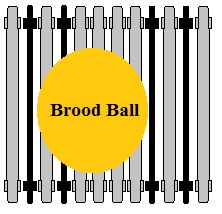When bees experience overcrowding within the hive they will
respond by swarming. This is the natural way that honeybee colonies reproduce.
Approximately half the bees in the hive will leave the hive along with the
existing queen bee. This relieves the overcrowding and is the way that bees
propagate new hives. When apiary hives swarm it results in a reduction in the
amount of honey that can be harvested. The bees put their energy into making a
new hive instead of producing honey. Recapturing the swarm is additional work
for the beekeeper and may result in the swarm invading a populated area causing
people to panic. There is a delicate balance that must be achieved by
beekeepers that hope to harvest surplus honey from their bees. Strong hives are
necessary to bring in enough nectar to make extra honey that can be harvested,
but strong hives are more likely to swarm due to overcrowding of the brood box.
 |
| Lewis Aspinwall - 1908 Swarm Prevention Frame, Patent Number 891,584 |
In 1897 Lewis Agustus Aspinwall patented a method of making
bees feel like they had adequate room so they would focus their attention on
honey production instead of swarming. Aspinwall's principle encouraged the bees
to expand their hive upward into the empty honey supers that were place on top
of the hive.

In my present hive I employ similar brood or comb frames, and
I prefer to arrange the same alternately with dummy frames that are filled in
with a series of similar or parallel strips or slats. These slats may be placed
in any desired direction and so close to one another as to leave between them
about a bee-space, and the slats are preferably as wide as the dummy frames,
and they are so close as to prevent the bees building comb in the frames, but
yet at the same time allowing room for the bees to travel through the dummy
frames from one comb frame to the next and in this way providing ample room for
all the bees and for the increase of the bees, so as to overcome the tendency
of the bees to swarm at certain periods.
Placing three CombForms™ side-by-side at the edge of the
brood ball creates the appropriate spacing and is hypothesized as another way
to utilize the Aspinwall method for swarm prevention. Preliminary testing
appears favorable; however, controlled trials supported by this crowd funding
project are needed.










